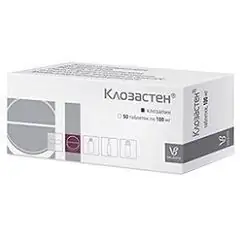- Author Rachel Wainwright [email protected].
- Public 2023-12-15 07:39.
- Last modified 2025-11-02 20:14.
Clozasten
Klosasten: instructions for use and reviews
- 1. Release form and composition
- 2. Pharmacological properties
- 3. Indications for use
- 4. Contraindications
- 5. Method of application and dosage
- 6. Side effects
- 7. Overdose
- 8. Special instructions
- 9. Application during pregnancy and lactation
- 10. Use in childhood
- 11. In case of impaired renal function
- 12. For violations of liver function
- 13. Drug interactions
- 14. Analogs
- 15. Terms and conditions of storage
- 16. Terms of dispensing from pharmacies
- 17. Reviews
- 18. Price in pharmacies
Latin name: Clozasten
ATX code: N05AH02
Active ingredient: clozapine (Clozapine)
Manufacturer: PAO Valenta Pharm (Russia)
Description and photo updated: 2018-29-11

Clozasten is an antipsychotic agent (neuroleptic).
Release form and composition
Dosage form - tablets: round, flat-cylindrical, greenish-yellow, with a bevelling (tablets at a dosage of 25 mg) or with a bevel and a score on one side (tablets at a dosage of 100 mg) (10 and 25 pcs. In blister contour packages, in a cardboard box 5 packs of 10 tablets or 2 packs of 25 tablets with instructions for the use of Clozasten).
Composition of 1 tablet:
- active substance: clozapine - 25 or 100 mg;
- auxiliary components: magnesium stearate, microcrystalline cellulose, lactose monohydrate, colloidal silicon dioxide (aerosil), croscarmellose sodium.
Pharmacological properties
Pharmacodynamics
The active substance of Clozastena - clozapine, is a derivative of dibenzodiazepine, has a sedative and pronounced antipsychotic effect. It almost does not cause the development of extrapyramidal disorders, therefore it belongs to the group of so-called atypical antipsychotics.
The antipsychotic effect of clozapine is due to its ability to block dopamine D2 receptors in the mesolimbic and mesocortical structures of the brain. The neuroleptic effect is close to that of aliphatic phenothiazines, but without unpleasant subjective sensations and "submelancholic shade". The drug does not lower the threshold of convulsive readiness, does not have a cataleptogenic effect.
The sedative effect is explained by such a property as blockade of α-adrenergic receptors of the reticular formation of the brain stem.
The hypothermic action develops as a result of blockade of dopamine receptors of the hypothalamus, antiemetic - as a result of blockade of dopamine D2 receptors in the trigger zone of the vomiting center.
Clozasten has an α-adrenergic blocking, peripheral and central m-anticholinergic effect. Does not affect higher intellectual functions and the concentration of prolactin in the blood.
The therapeutic effect of the drug occurs in several stages:
- Sedative and hypnotic effects develop rapidly;
- Anxiety is stopped;
- Aggressiveness and excitement are eliminated (after 3-6 days);
- An antipsychotic effect develops (after 7-14 days);
- The effect on the symptoms of negativism is noted (after 20-40 days).
Pharmacokinetics
When taken orally, clozapine is well absorbed from the gastrointestinal tract. It is characterized by variable bioavailability - from 27 to 60%.
The maximum plasma concentration (C max) is determined after 1-6 hours (on average, 2.5 hours). Stable equilibrium plasma concentrations (Css) are reached within 8-10 days and are 102-771 ng / ml (average 319 ng / ml).
95% of clozapine binds to plasma proteins. The substance is quickly distributed in the body, accumulates in the parenchymal organs (kidneys, liver, lungs).
It is metabolized in the liver. It is biotransformed with the participation of the CYP1A2 enzyme system with the formation of metabolites that do not have or have a weak pharmacological activity. The drug is excreted by the kidneys (50%) and with bile (35%).
The half-life (T 1/2) is highly variable. After a single dose of Clozasten at a dose of 75 mg is 4-12 hours, when taking a dose of 100 mg 2 times a day - 4-66 hours.
Indications for use
- sleep disorder;
- emotional and behavioral disorders (including in children);
- psychomotor agitation with psychopathies;
- affective insanity;
- manic states;
- acute and chronic forms of schizophrenia (including a disease resistant to other antipsychotics, as well as in cases of intolerance to antipsychotics).
Contraindications
Absolute:
- toxic psychosis (including alcoholic);
- coma;
- oppression of bone marrow hematopoiesis;
- a history of agranulocytosis or granulocytopenia (except for cases of their development due to previous chemotherapy);
- myasthenia gravis;
- lactose intolerance, lactase deficiency and glucose-galactose malabsorption;
- children up to age 16;
- period of pregnancy and lactation;
- hypersensitivity to any component of the drug.
Relative (Clozasten should be used with caution):
- epilepsy;
- angle-closure glaucoma;
- decompensated diseases of the cardiovascular system;
- intercurrent diseases with febrile syndrome;
- intestinal atony;
- severe hepatic and / or renal impairment;
- hyperplasia of the prostate.
Clozasten, instructions for use: method and dosage
Clozasten tablets should be taken orally, after meals. The daily dose prescribed by the doctor is divided into 2 or 3 doses.
The attending physician selects the optimal dose individually. Treatment begins with a minimum dose (25 mg) and gradually (by 25-50 mg per day) is increased until the desired therapeutic effect is achieved, taking into account the stages of its manifestation.
A single dose can vary between 50-200 mg, the initial daily dose is 150-300 mg. The average daily dose is 200-400 mg, the maximum allowable dose is 600 mg per day.
In milder forms of the disease for maintenance therapy, as well as for patients with cerebrovascular disorders, chronic heart failure, renal or hepatic insufficiency, Clozasten is prescribed in lower doses - 25-200 mg per day.
Side effects
- from the central nervous system: increased body temperature, headache, agitation, dizziness, akathisia, fainting, drowsiness, confusion; rarely - sleep disturbances, insomnia, depression, tardive dyskinesia, epileptic seizures, extrapyramidal disorders (tremor, muscle rigidity, hypokinesia or akinesia), neuroleptic malignant syndrome (pallor of the skin, weakness, excessive fatigue, fever, severe muscle rigidity, urination, difficulty breathing or tachypnea, unstable blood pressure, arrhythmia, tachycardia, seizures);
- from the hematopoietic organs: thrombocytopenia, leukopenia, granulocytopenia, up to agranulocytosis, the first signs of which may be flu-like symptoms, such as fever, chills, inflammation of the gums and oral mucosa, sore throat, furunculosis, sluggish healing wounds or exacerbation of chronic latent foci of infection - periostitis, tonsillitis, pyoderma;
- from the digestive system: dry mouth, heartburn, hypersalivation, constipation, nausea, vomiting;
- from the genitourinary system: urinary retention, decreased potency;
- on the part of the cardiovascular system: lowering blood pressure (including orthostatic hypotension); less often - tachycardia, increased blood pressure, flattening of the T wave on the electrocardiogram;
- on the part of the musculoskeletal system: myasthenia gravis;
- from the side of metabolism: increased body weight;
- from the senses: violation of accommodation.
Overdose
Symptoms: drowsiness, delirious disorders, stunnedness, agitation, anxiety, soporosis, development of large epileptic seizures, coma, lability of body temperature, heart rhythm disturbances, decreased blood pressure, tachycardia, collapse, respiratory depression, intestinal atony.
Treatment: gastric lavage, sorbent intake, control of electrolyte balance and acid-base state, maintenance of respiratory and cardiovascular functions, symptomatic therapy. Within 4 days after the signs of an overdose disappear, the patient should be under close medical supervision in order to identify possible late complications in time. Hemodialysis and peritoneal dialysis are ineffective.
special instructions
During the period of therapy, the use of alcoholic beverages is not recommended.
Every day at the beginning of treatment, then every 3-4 months, the blood picture should be monitored. In case of development of granulocytopenia, Clozasten is immediately canceled.
With the development of arterial hypotension against the background of antipsychotic therapy, angiotensin or norepinephrine derivatives are prescribed.
Clozasten belongs to the list of potent substances and the list of subject-quantitative accounting in pharmacies.
Influence on the ability to drive vehicles and complex mechanisms
Due to the risk of developing adverse reactions from the central nervous system while taking Clozasten, caution should be exercised by motor vehicle drivers and patients performing potentially hazardous types of work that require speed of psychomotor reactions and increased attention.
Application during pregnancy and lactation
During pregnancy, the use of Clozasten is contraindicated.
If taking the drug is required during lactation, breastfeeding should be discontinued.
Pediatric use
Clozasten tablets are not used to treat children under 16 years of age.
With impaired renal function
Renal failure is a relative contraindication to the use of Clozasten, therefore drug therapy should be carried out with caution.
Dose adjustment required.
For violations of liver function
Liver failure is a relative contraindication to the use of Clozasten, therefore drug therapy should be carried out with caution.
Dose adjustment required.
Drug interactions
Clozasten inhibits the action of levodopa and other dopaminostimulants. Strengthens the effects of drugs for general anesthesia, antihypertensive drugs, narcotic analgesics, hypnotics and sedatives, monoamine oxidase (MAO) inhibitors, ethanol.
Gel antacids and cholestyramine impair the absorption of clozapine.
Lithium preparations increase Clozasten's neurotoxicity (extrapyramidal disorders, delirium, convulsions), myelotoxic drugs - manifestations of its hematotoxicity.
Pentetrazole increases the likelihood of seizures.
The simultaneous use of benzodiazepines can cause an excessive decrease in pressure, impaired consciousness, depression and respiratory arrest.
Caution is required if the combined use of anticoagulants, antiepileptic, antimicrobial or hypoglycemic (sulfonylurea derivatives) agents is necessary.
Clozasten should not be used simultaneously with the following drugs: antipsychotic and antimalarial drugs, antidepressants (including tricyclic drugs), thyreostatics, gold preparations, carbamazepine, as well as drugs that damage blood cells (pyrazolone-containing non-steroidal anti-inflammatory drugs).
Analogs
Clozasten's analogs are Abilify, Azaleptin, Azaleprol, Amdoal, Betamax, Viktoel, Haloperidol, Droperidol, Zalasta, Zyprexa, Quentiax, Clopixol, Leptinorm, Majeptil, Neuleptil, Olanzapin, Propazin, Serdaperispolon, Fispaxol, Etperazin, etc.
Terms and conditions of storage
Store at temperatures up to 25 ° C out of reach of children, protected from light.
Shelf life is 2 years.
Terms of dispensing from pharmacies
Dispensed by prescription.
Reviews about Klosasten
There are practically no reviews about Klosasten on specialized medical sites and forums. There are rare messages, both positive and negative. Firstly, patients describe the effectiveness of the neuroleptic, and secondly, the absence or insufficiency of the effect of taking the drug.
The price of Klosasten in pharmacies
The approximate price for Clozasten in a dosage of 100 mg (50 tablets per pack) is 1332-1385 rubles.

Anna Kozlova Medical journalist About the author
Education: Rostov State Medical University, specialty "General Medicine".
Information about the drug is generalized, provided for informational purposes only and does not replace the official instructions. Self-medication is hazardous to health!






